Permanent Adoptions
By Emily Gold Boutilier
When the Mead Art Museum chooses to acquire a new work of art, it takes the long view. “We look at a 500-year window,” says Director Elizabeth E. Barker. “We’ll have it forever. It’s like a permanent adoption.”
Given the serious commitment involved, curators at the Mead take no acquisition lightly. They consider quality, condition and importance, as well as how a particular work relates to the other items in the museum, Barker says.
They ask: What might scholars discover about the object? What will future generations gain from its preservation? Does it improve the collection? Is it the best possible example of its type?

Over the decades, the Mead’s collection has expanded in irregular spurts, one of which has just concluded. The museum has added 900 objects to its 18,000-item collection since Barker’s arrival at Amherst in 2007. Highlights of these recent acquisitions include a painting by Impressionist Alfred Sisley, 200 drawings and photographs by Jared French ’25, a collection of Chinese snuff bottles and hundreds of Japanese, Russian and American prints.
Now a special exhibition, Art for All: Additions to the Collection From Antiquity to Today, puts on display 130 of these paintings, drawings, photographs, prints, ceramics, glass objects, sculptures, masks, scrolls, videos and antiquities. Most are on view for the first time ever.
The Mead’s goal in acquiring art is to build on its existing strengths, Barker says, rather than to fill gaps in its collection. Those strengths include, among others, 19th-century American landscape paintings, Italian Renaissance paintings, early-20th-century Russian art, Mexican folk art, Japanese prints and art of the Yoruba people. “We have a really diverse collection,” Barker says, “but we’re not trying to grow to be the Louvre or the British Museum. We don’t feel responsible for collecting from every culture, every era.”
The first iteration of the exhibition is on view through July 7. A second display, featuring a different group of newly acquired works, will run from Aug. 16 to Dec. 29.

The Manor of the White Cross at Saint-Mammès, September Afternoon (Le Château de la Croix-Blanche à Saint-Mammès après-midi de Septembre)
1884, Alfred Sisley
Sisley used color to define forms in this oil on canvas, rather than (as fellow Impressionist Claude Monet would do) to dissolve them. This scene captures one of Sisley’s favorite haunts: Saint-Mammès, France. Preserved in its original frame, the painting remained until 2011 in the family that had purchased it from the artist’s dealer. It is a gift of the late John C. Haas ’40 and Chara C. Haas.

Chinese snuff bottles
ca. 1800–1900
Snuff bottles first became popular in China in the 17th century. Among the most intriguing of these miniature works of art are glass bottles with “inside painting,” figural scenes painted with tiny brushes on the interior through the narrow neck. Twenty bottles came to the Mead in recent years from the late aerospace engineer Lawrence M. Mead Jr., grandnephew of the museum’s namesake, architect William Rutherford Mead.
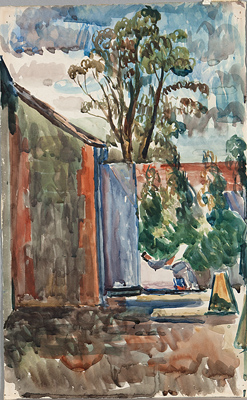
In the Garden
undated, Vanessa Bell
Three recently acquired works—including this watercolor on paper—represent Amherst’s first foray into the art of the Bloomsbury Group, an informal association of friends and relatives that gathered in London during the first few decades of the 20th century. Its members included, among others, writer Virginia Woolf and economist John Maynard Keynes, as well as Bell, who was Woolf’s sister. All three works are given in memory, and come from the collection, of Amherst Professor of English William Webster Heath ’51 and Mary Louise Townsend Heath.

You Are My Bird
1968, by Niki de Saint Phalle
In this fiberglass and polyester sculpture, the artist’s subconscious plays a more influential role than her immediate perception of reality. The abstracted and dramatized birdlike form features primitive patterns and themes that recur in Saint Phalle’s work. It’s a bequest of Richard S. Zeisler ’37.
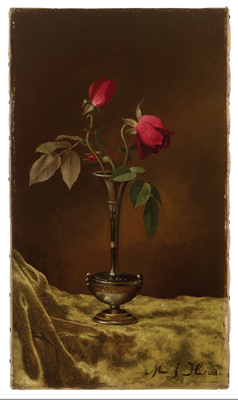
Three Red Roses in a Metal Vase on Gold Velvet
ca. 1883–1900, Martin Johnson Heade
Heade painted a succession of specific flowers—magnolias, white Cherokee roses and (as in this oil on canvas) red roses—after moving to St. Augustine, Fla., in 1883. The Mead received this still life from John A. Quisenberry ’60, who plans for his entire collection to eventually come to Amherst.
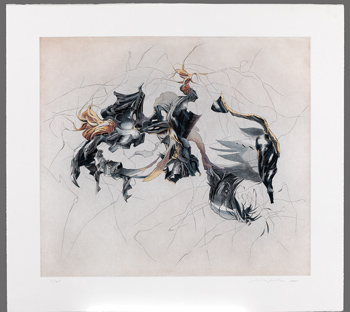
Rainbow 6: Relayer
2007, Aaron Noble
Noble takes inspiration from the obsessively detailed exaggeration of the human form found in comic books of the 1990s. This color etching and aquatint depicts weapons, human hair, horses, mechanical claws and other elements that combine in a web of lines. Like the Daughters of the East print, it was purchased through the Student Acquisition Fund.
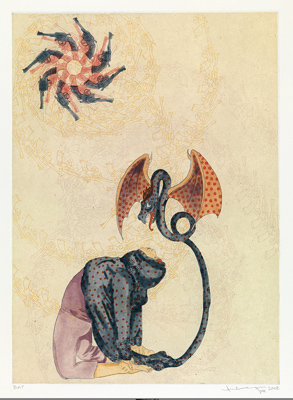
Untitled from the series Daughters of the East
2008, Ambreen Butt
This is among the contemporary prints selected by Amherst students and purchased through the Trinkett Clark Memorial Student Acquisition Fund. The artist—a Pakistani Muslim—created the Daughters of the East series in the wake of the 2007 assassination of former Pakistani Prime Minister Benazir Bhutto. In this print, a woman’s garment coalesces into a flying dragon.

Oshiguma
after 1956, Kawarasaki Gonjūrō III as Michizane in the play Sugaware Denju Tenarai Kagami (Sugawara and the Secrets of Calligraphy), Act 4
An oshiguma is an impression of a Kabuki actor’s makeup on a silk towel, taken right after a performance. After the makeup has completely dried, the actor signs the oshiguma and stamps it with his personal seal. This oshiguma is one of 111 that came to Amherst as part of a bequest from Howard B. Hamilton, who spent decades in Hiroshima studying the effects of radiation on victims of the atomic bomb. The Mead is one of only two U.S. public collections (the other is the Library of Congress) to hold collections of these rare prints.
One room in the exhibition is devoted to work by Amherst alumni:

Selling Sandals, Addis Ababa, Ethiopia
2003, Stephen Petegorsky ’75
This image portrays men in wheelchairs as they try to make money by selling sandals in the streets. It is one of many photographs in which Petegorsky documents the efforts of the Polus Center for Social and Economic Development. The pigment inkjet print is a gift of the artist.

Garden Chair
2011, Elizabeth Hoak-Doering ’88
Hoak-Doering creates art that most often focuses on Cyprus, where she is an assistant professor at the University of Nicosia. This drawing is among those produced through her installation in the 2011 Venice Biennale of Art, where she represented Cyprus. Visitors to the installation indirectly moved pieces of furniture suspended from the ceiling, by triggering motion detectors attached to small motors. As each hanging object searched for a resting point, it created movements recorded as “drawings” by an attached graphite pencil. This work is a gift of the artist.
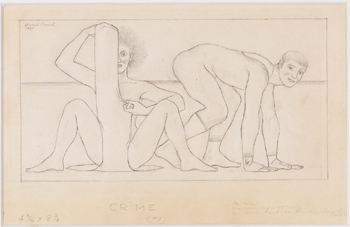
Crime
1939, Jared French ’25
This work is part of a series of 49 paintings and drawings in which the artist sought to define the whole of human nature and experience. It consists of graphite and conté crayon or chalk on tan wove paper. Its purchase was made possible with support from members of the artist’s family: Andrew J. Shilling ’89 and Kirsten N. Shilling; Jennifer S. Stein ’93 and Josh B. Stein; and A. Gary Shilling ’59 and Margaret B. Shilling. In conjunction, Archives and Special Collections at Frost Library acquired some 50 personal letters written to French.
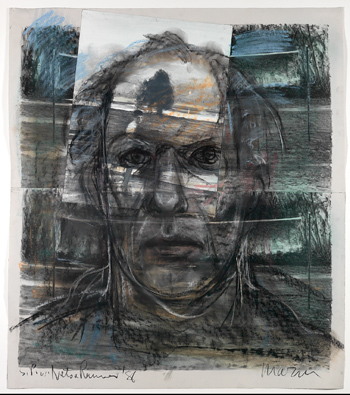
Self-portrait
1986, Michael Mazur ’57
This late, prolific artist is among the best-known figures in contemporary art who is associated with Amherst. He was particularly fond of and adept at rendering trees—forms he saw as analogous to human bodies. This mixed-media self-portrait is a pastel over a lithograph print and paper collage. It is a gift of Jean and Kyra Montagu.
Top photograph by David Dashiell. Photographs of Sisley, Bell, Noble, Butt and Heade works by Stephen Petegorsky ’75; snuff bottles and Ullrich, Saint Phalle and French objects by David Dashiell; oshiguma by Elizabeth Critchfield ’12 and Stephen Fisher; Hoak-Doering drawing courtesy of the artist; Mazur portrait by Petegorsky/Gipe.
Bell painting ©Estate of Vanessa Bell/Courtesy of Henrietta Garnett. Ullrich print ©2013 Artists Rights Society (ARS), New York/VG Bild-Kunst, Bonn. Saint Phalle object ©Estate of Niki de Saint Phalle. Noble and Butt prints published and printed by Wingate Studio. Petegorksy photo ©Stephen Petegorsky. Hoak-Doering drawing ©2011 Elizabeth Hoak-Doering. French drawing reproduced with permission of his family. Mazur portrait reproduced with permission of the Estate of Michael Mazur. All others reproduced with permission of the Mead.